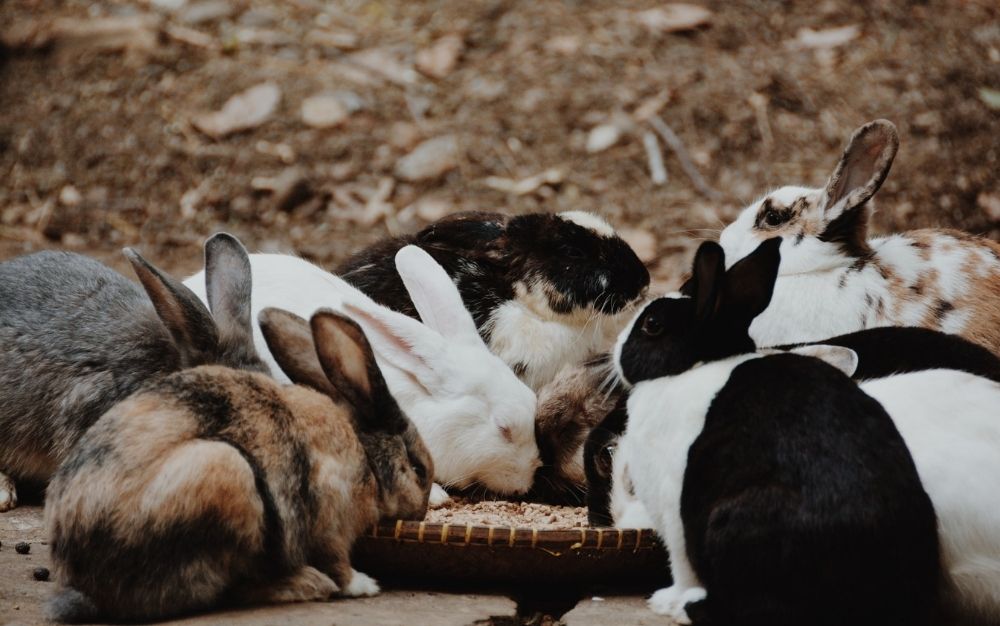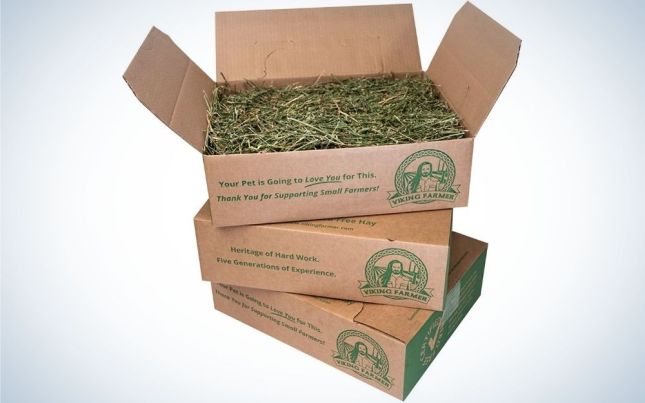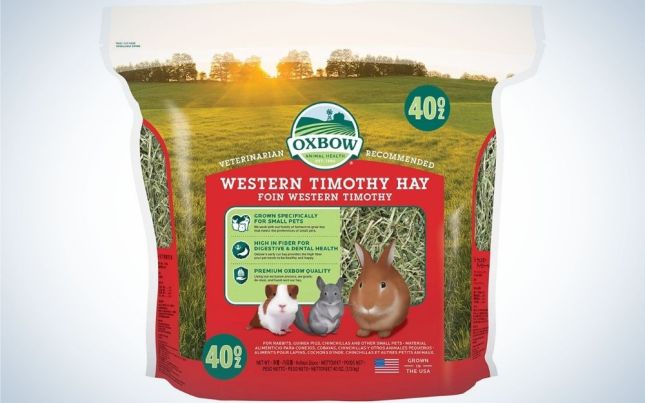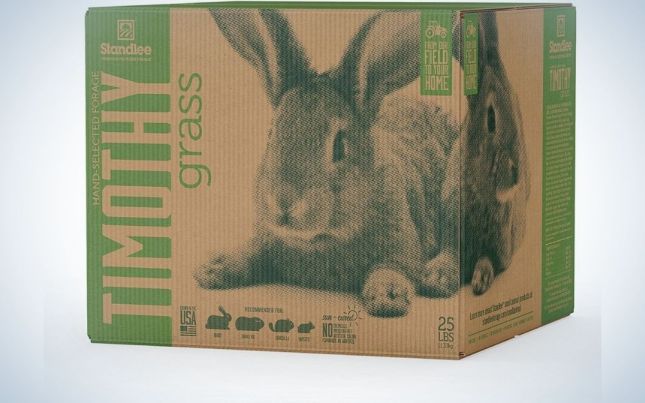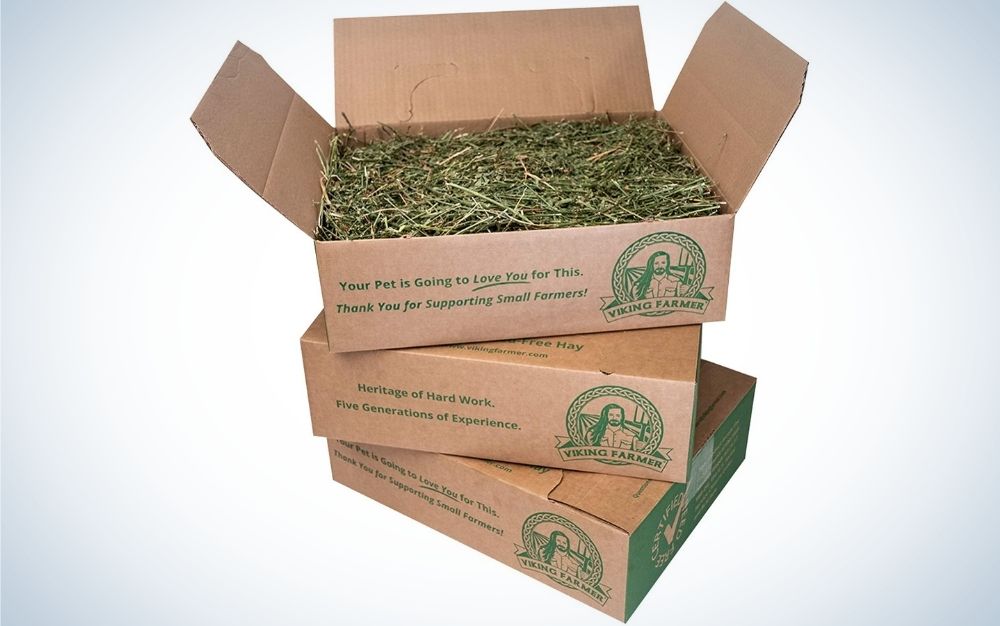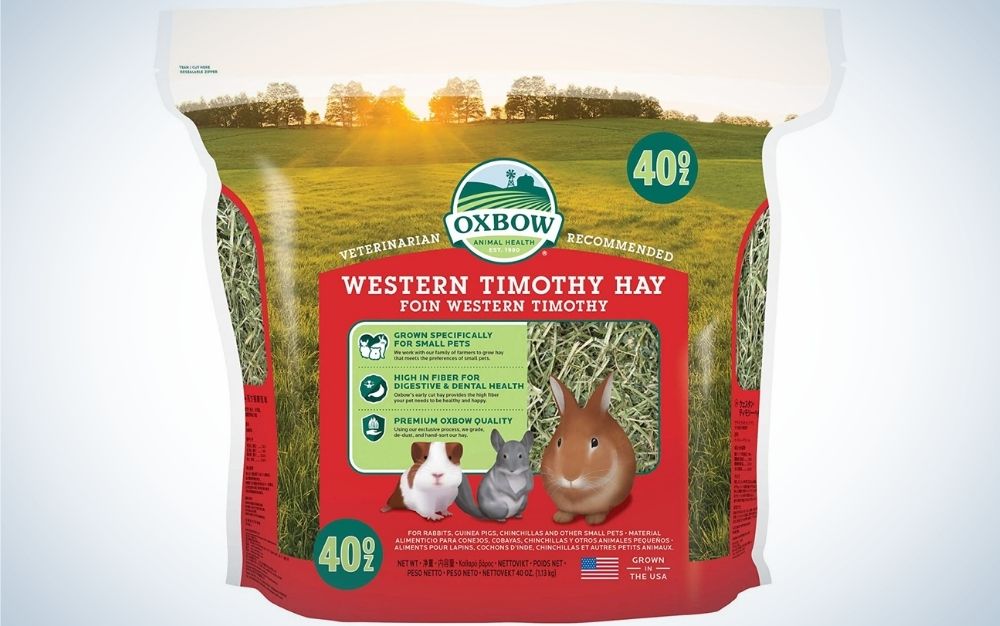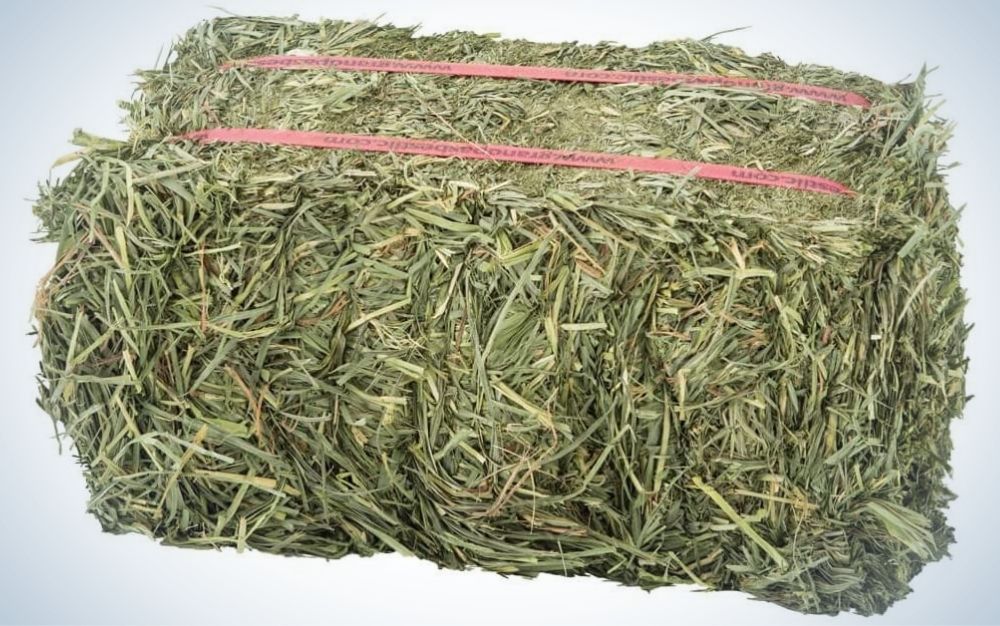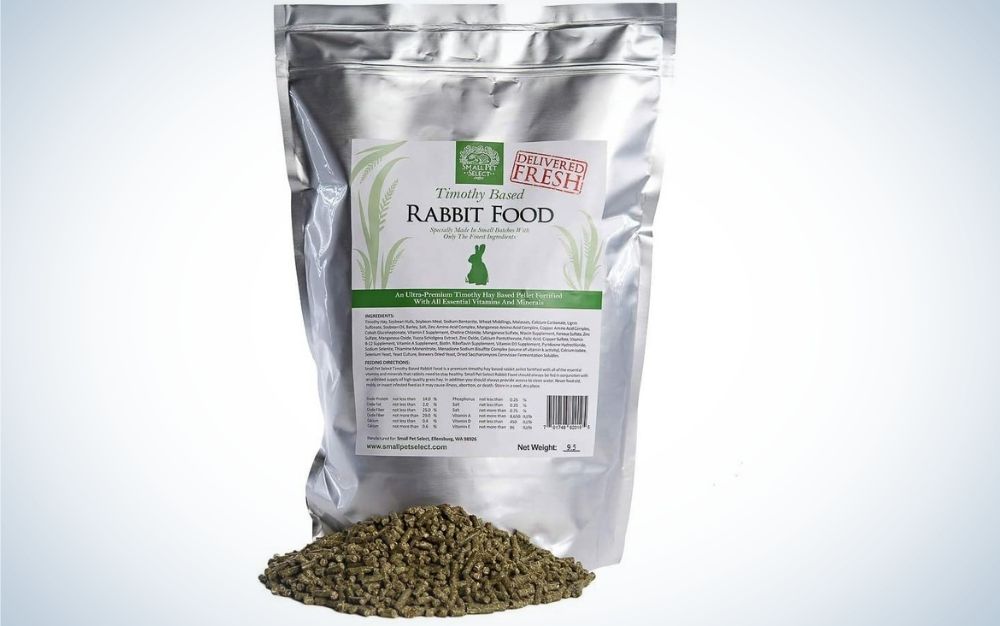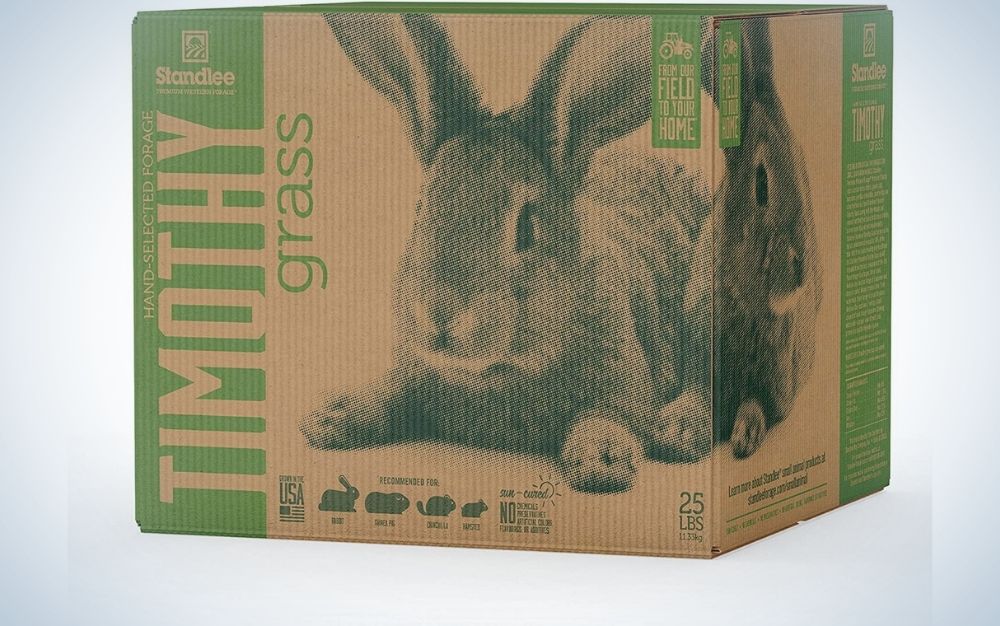We may earn revenue from the products available on this page and participate in affiliate programs. Learn More ›
According to legend, the Aztec goddess Mayahuel gave birth to 400 rabbits collectively called the Centzon Totochtin. These magical bunnies visited human parties, bestowing the gift of drunkenness (apparently cheese plates weren’t in fashion then). Rabbits play trickster roles in most folklore—and that association makes a lot of sense when you consider how unexpectedly tricky cuniculture and rabbit keeping can be. This is especially true when it comes to the rabbit diet and figuring out what to feed rabbits. A basic understanding of rabbit biology is necessary to select the best rabbit food for your pet bunnies or rabbit livestock.
- Best Rabbit Hay For Kits: Viking Farmer Alfalfa Hay
- Best Adult Rabbit Hay: Oxbow Timothy Hay
- Best Rabbit Hay For Allergic Humans: Grandpa’s Best Orchard Grass
- Best Rabbit Pellets: Small Pet Select Pellets
- Best Budget Rabbit Hay: Standlee Timothy Hay
Rabbit Bio 101: The Best Rabbit Food for Lagomorphs
To select the best bunny food, a little animal science is necessary. Rabbits were once considered rodents, but actually belong to a group of animals called lagomorphs. This scientific order comprises herbivores with very specific dental characteristics: incisors that grow continuously and a space (called a diastema) that separates the incisors from the back teeth.
Because those incisors never stop growing—sort of like human fingernails—rabbits must keep them ground down lest they become unwieldy tusks that make it difficult or painful to eat. In the wild, rabbit food is the key to managing this dental situation since constant munching on tough, fibrous plants keeps those teeth at the proper length.
All that tough plant matter in the rabbit diet requires a boost when it comes to breaking it down for digestion. Rabbits rely on a healthy population of gut bacteria to do that job. It’s a great system for a rabbit that eats the right things, but if a rabbit doesn’t get enough fibrous material in its diet, the gut bacteria will fall out of balance, grinding the digestive system to a sudden halt. This is a veterinary emergency called stasis that can be fatal for rabbits within 24 hours of onset.
To keep rabbits healthy and happy, it’s crucial to pick the best rabbit food to meet the unique needs of the lagomorph digestive system. The bottom line? Hay, hay, and more hay.
How To Provide An Ideal Baby Rabbit Diet
Kits and juvenile rabbits have specific nutritional needs, and the best rabbit food will take the rabbit’s life stage into account. For the first 3 weeks of a kit’s life, it should receive its mother’s milk exclusively. Between weeks 4 and 7, the kit will begin to transition to a diet of rabbit hay and pellets.
The best hay and pellets for growing rabbits is alfalfa. This crop is actually a legume, so it’s more nutritionally dense than a grass-based hay. Early bloom alfalfa contains about 18% protein—about twice the protein of timothy hay. Alfalfa hay also contains more calcium, calories, and fat.
Juvenile rabbits should have access to unlimited alfalfa hay and pellets until they are 7 months old. You can also begin adding small quantities of rabbit-safe vegetables one at a time to the rabbit diet beginning at 12 weeks.
Best Rabbit Hay For Kits: Viking Farmer Alfalfa Hay
Viking Farmer consistently offers high quality, high protein alfalfa that arrives fresh and free of preservatives and pesticides. It comes in a convenient, rabbit-friendly cardboard box.
Hay: The Keystone Of An Adult Rabbit Diet
Once a rabbit is 7 months old, its rabbit food needs will change. At this point, that alfalfa hay loaded with protein and calcium is simply too much—and can be tough on the rabbit excretory system. It’s time to switch to timothy hay, which contains about 9% protein.
Since rabbits need to chew almost constantly to keep those teeth ground down and the delicate digestive system moving, rabbits should have unlimited access to hay and water at all times. Rabbits tend to nest where they eat, so it’s a good idea to add a pile of hay about the size of the bunny to the hay feeder or box every day.
When selecting hay, the package or product description sometimes indicates the cutting for the rabbit hay. First cut hay is early season hay, which is higher in fiber and lower in protein and fat. It’s also lighter in color and has more stems than leaves. This is great hay for rabbits prone to digestive problems. Second cut hay is greener and has more leaves, so its fiber content is slightly lower. Healthy adult rabbits may find this hay more appealing. Third cut hay is highest in protein and lowest in fiber. It’s green and fluffy and best given as rabbit treats or to help underweight rabbits tank up.
Best Adult Rabbit Hay: Oxbow Timothy Hay
Oxbow is a premium timothy produced without additives or fillers. It’s processed by hand, so the bag arrives full of usable hay with minimum timothy dust to shake out.
What To Feed Rabbits If You’re Allergic to Timothy Hay
While timothy hay is the go-to rabbit hay for both pet rabbits and livestock, many people find this hay triggers mild to moderate allergy symptoms. This is an important consideration since rabbit keeping means lots of contact with hay—and it’s especially important for people who keep their rabbits inside.
If timothy hay makes your head ache, your sinuses scream, and your arms break out in blotches, try a less allergenic hay like orchard grass. Other options include oat hay, meadow grass, and brome.
In addition to unlimited hay, offer your rabbits wild rabbit food aka fresh greens. An adult rabbit will eat about 2 cups of chopped green veggies per day. Sugary vegetables (like carrots) and fruits should be considered rabbit treats and offered only in small quantities.
Best Rabbit Hay For Allergic Humans: Grandpa’s Best Orchard Grass
Grandpa’s Best is a small farm with chemical-free pastures. The tender grass is hand-packaged into compressed bales for convenient storage.
Supplementing The Rabbit Diet With Pellets
In addition to unlimited hay, adult rabbits need nutritionally dense pellets in measured amounts. An adult bunny should receive about ½ cup of pellets per day per 6 pounds of body weight. Rabbits with slower metabolisms or who have ever had signs of stasis—small or no droppings, loss of appetite, and lethargy—should receive only ¼ cup of pellets per day per 6 pounds of body weight.
It’s important to monitor the quality of a rabbit’s droppings for early signs of stasis and also to take note of any cecotropes. These are small, shiny droppings that are softer than regular droppings and look like clusters of grapes. These droppings pass through the intestines and then are consumed by the rabbit to glean extra nutrients and keep the gut bacteria in balance.
Rabbits almost always eat their cecotropes in private, so finding cecotropes in the hutch or litter box is a sign of a rabbit diet that’s too rich. If you find these droppings, simply reduce the amount of pellets and greens you offer to help shift the rabbit to eating more hay.
Best Rabbit Pellets: Small Pet Select Pellets
Small Pet Select’s timothy pellets are fresh because they are processed in small batches from the current year’s crop of timothy grass. They are fortified with vitamins for optimal rabbit health.
Budget Rabbit Food
Since rabbits need to munch on rabbit food almost constantly, the cost of hay along with other rabbit supplies can really add up. When you’re trying to figure out what to feed rabbits on a budget, the key word is bulk.
Hay produced for rabbits and other small animals is the same as hay produced for large livestock like horses. The best way to save money on hay is to purchase full bales from a local feed store or farmer. You can expect to spend about the same amount of money to buy a 95-pound bale as you’ll spend on 5 pounds of hay produced for small animals.
Of course, transporting and storing almost 100 pounds of hay might be difficult or impossible for many rabbit keepers. Some feed stores will allow customers to purchase smaller bags from a hay bale set aside for that purpose, sweep up the hay that falls from the bales, or help connect rabbit keepers with each other to split a bale.
When buying in mega-bulk isn’t feasible, buying in quantities that are bigger (but still manageable) will save money. For example, if you can store 25 pounds of hay, you’ll likely get a better deal than if you can only keep 5 pounds. Look for hay from a reputable hay company and check the price per ounce. One of the unique things about rabbit hay is that smaller, farmer-owned companies that specialize in rabbit hay will usually offer a higher quality product at a lower price compared to those offered by larger, less specialized companies.
Best Budget Rabbit Hay: Standlee Timothy Hay
Standlee is a family farm that offers larger boxes of high quality hay. This product is high fiber and low protein for healthy adult rabbits.
FAQs
A healthy adult rabbit’s daily diet should include ½ cup of high quality timothy pellets per 6 pounds of body weight, plus about 2 cups of rabbit-safe greens and veggies. Rabbits should have unlimited access to timothy hay or orchard grass and fresh drinking water.
Some foods can kill a rabbit. Never feed a bunny chocolate, rhubarb, garlic, onion, popcorn, seeds, crackers, bread, yogurt, beans, nuts, potatoes, or iceberg lettuce. It’s a good idea to limit cruciferous vegetables that can cause gas, such as broccoli, cabbage, and brussels sprouts. Also limit access to sugary foods like carrots and fruits.
Rabbits do not need salt blocks if they receive a good diet of unlimited hay, measured pellets, and fresh greens. If you are concerned your rabbit isn’t receiving the minerals it needs, it’s a good idea to talk with your veterinarian.
A Final Tip on Finding the Best Rabbit Food
Whether your rabbits are pampered house pets or valuable livestock, choosing the best rabbit food is really about understanding lagomorph biology. To keep the growth of their teeth in check and their sensitive digestive systems humming, rabbits require free access to unlimited hay and water. They also need high quality pellets and greens to fortify their diet. With a little knowledge of bunny biology, knowing what to feed rabbits isn’t really that tricky after all.
Find more products and gear reviews on Outdoor Life.
